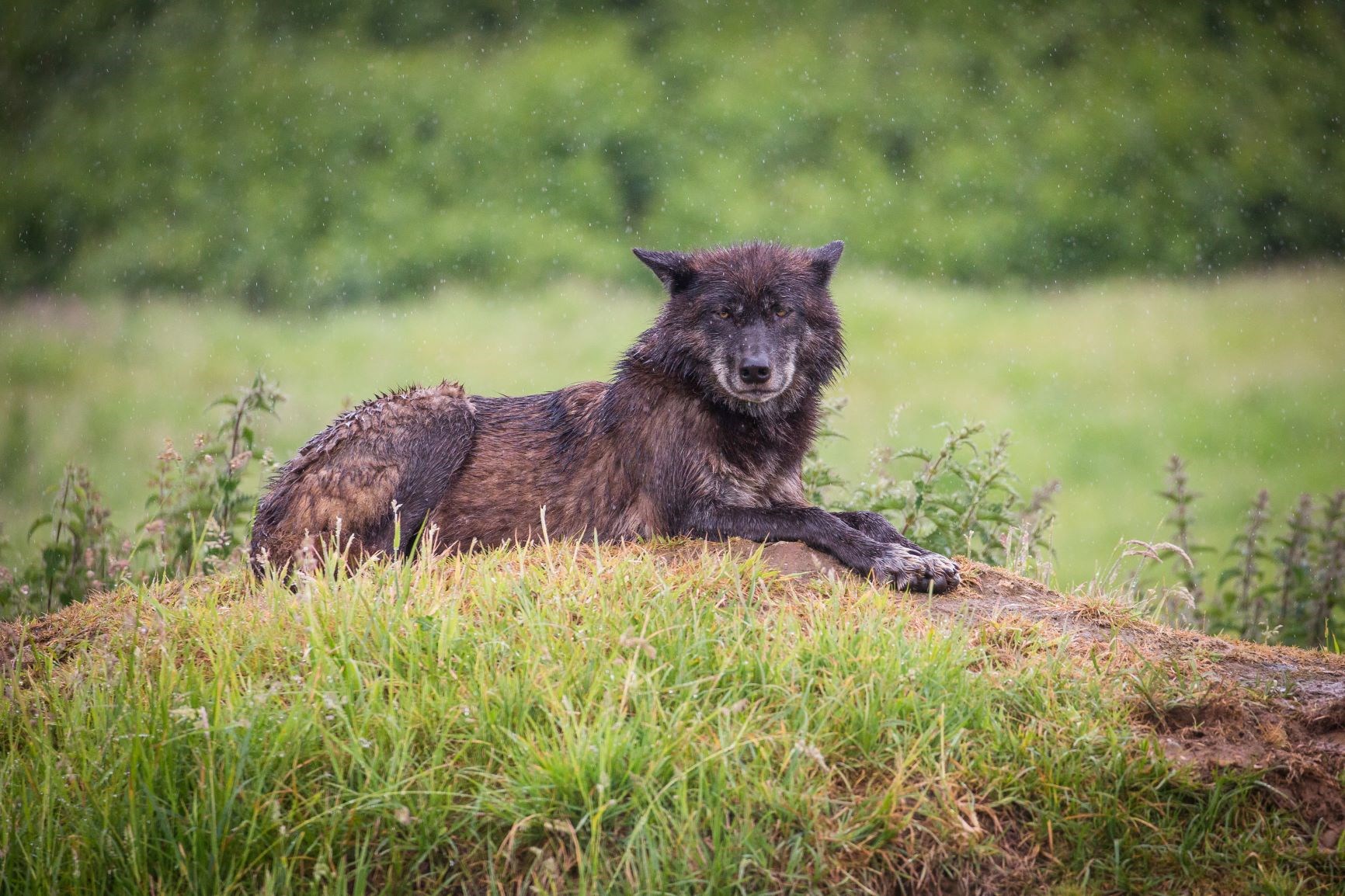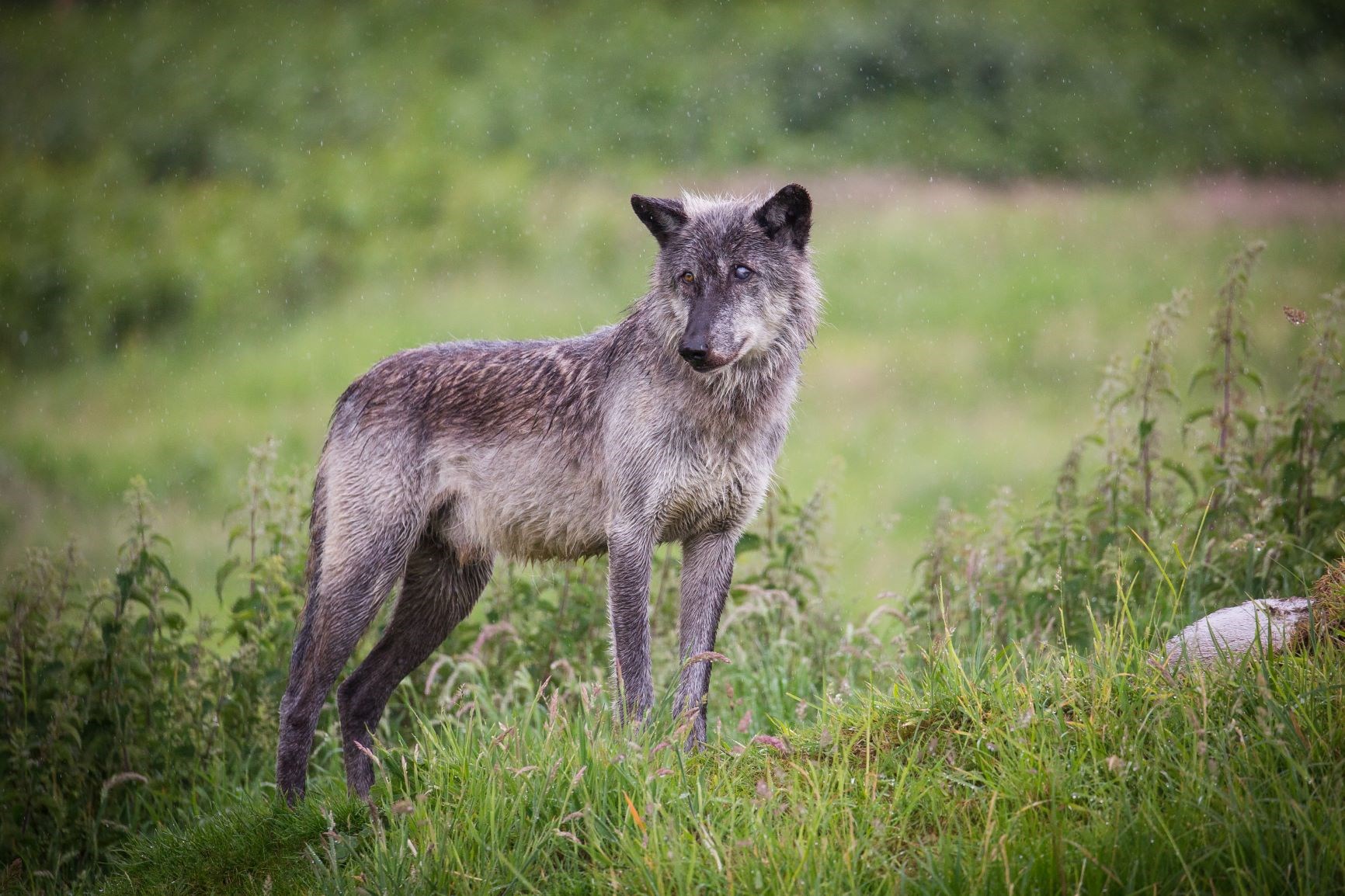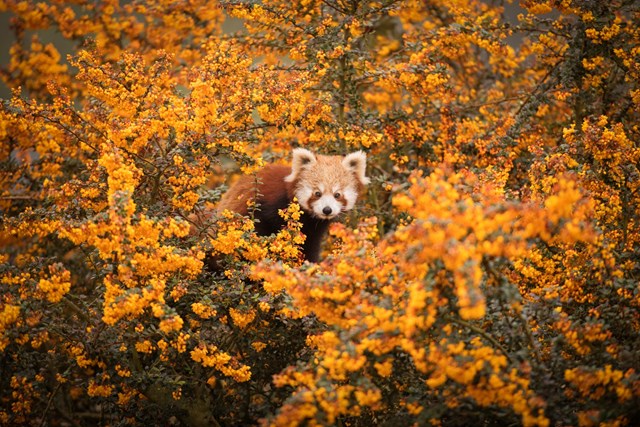Overview
At Woburn Safari Park there is a mixed exhibit made up of a small family of wolves, male Akela, and female Tala.
These wolves live in a 13 acre enclosure which they share with our North American Black Bears.
The Canadian timber wolf is the largest subspecies of wolf, living and hunting in packs of up to ten or 12 members in the wild. They are the most wide-ranging of carnivores and can take prey up to ten times their size because of their hunting techniques.

All about us
| Distribution: | Northern Hemisphere, including Canada and Alaska. |
|---|---|
| Habitat: | Woodlands, mountains and tundra (arid grassland) |
| Height: | Up to 52cm at shoulder. Length: 1 to 1.3m including tail |
| Weight: | 23 to 79 kg |
| Lifespan: | 6 to 8 years (10-15 years in captivity) |
| Threats: | Hunting due to conflict with humans |
About us
Scientific name: Canis lupus
Despite the name ‘grey wolf’ the timber wolf’s coat can actually range from white, brown, black to grey in colour. The wolf has a double coat of fur; long guard hairs on top and a layer of soft insulating underfur. The guard hairs can be as long as four inches and works to help shed moisture like a raincoat. Their underfur keeps the wolf warm in the cold months and is shed in summer.

Males tend to be up to 20% bigger and heavier compared to females.
Despite the name ‘grey wolf’ the timber wolf’s coat can actually range from white, brown, black to grey in colour. The wolf has a double coat of fur; long guard hairs on top and a layer of soft insulating underfur. The guard hairs can be as long as four inches and works to help shed moisture like a raincoat. Their underfur keeps the wolf warm in the cold months and is shed in summer.
Wolves have a total of 42 teeth, of which 40 of them will help secure their prey when hunting. The incisors at the front of the jaw are used to cut the flesh of their prey. The largest teeth are the canines, which can reach almost two and a quarter inches in length. These are used to pierce into the flesh to hold their prey. The premolars and molars are used for slicing and grinding meat. The last premolars in the upper jaw and first molars in the lower jaw, also know as the carnassials are especially designed to slice and shear flesh. The last molars are used for grinding and pulverizing the food prior to digestion.
The wolf’s sense of smell is around 100 times better than that of a human. They use their sense of smell to locate prey. Wolves have the ability to smell prey before they can see it, from more than a mile away if the wind is right.
Wolves will live, hunt and travel as a pack. They are social animals, communicating with other members of the pack with howls, barks, growls and whines. A wolf pack can be up to 12 individual members, all controlled by the alpha male and female. A pack will look out for each individual, for the benefit of the whole pack, travelling miles in seach of food. When a female gives birth to a litter of pups, other females in the group bring food back to the den.
Packs can ‘own’ territories of up to 5,200 square miles. This can increase depending on the number of individuals in the pack and the quality of habitat. All members of a pack will help to defend the territory, travelling together in single file along set routes at least once a month.
Wolves will generally reach sexual maturity around 2 – 3 years of age. When a female comes into estrus she will bleed for up to 14 days and the pair will mate 2 - 3 times a day. An alpha female can have a litter of up to 11 pups (the average is 6), born in the den after a gestation of 63 days. The pups are born blind and deaf, gaining their sight and hearing within a week. Pups will remain in the den with their mother until they are 5 weeks of age, when they’ll be weaned by the mother and then reared by the entire wolf pack. Depending on the quality of habitat, the juveniles may leave the pack from as early as 12 months or as late as full maturity at roughly 22 months of age.
In the wild a wolf’s diet consists of ungulates (large hoofed mammals), such as elk, deer, moose and caribou. Working as a pack, wolves bring down prey much larger than themselves. They are also known to eat smaller prey such as beavers, rabbits and even rodents. Food sources can be sparce in winter months, when packs can go without food for weeks. If necessary, they will scavenge and eat the remains of other animals that have died, eg. from starvation.
Wolves in captivity require an enclosure which allows them to express their natural behaviours. Unfortunately, in captivity wolves are unable to hunt as they would in the wild. Keepers find methods to help packs expend the energy they normally would during a hunt. Providing whole animal carcasses as food or only feeding packs intermittently, with starve days in between, will replicate their natural feeding behaviour.
Packs in captivity are generally made up of an alpha pair and their offspring.
When new wolves are introduced to the pack for breeding purposes, the process of integration into an established pack is a lengthy one. Wolves will fight to establish their position in pack hierarchy and will occasionally inflict wounds on each other.
Zoos and Safari park animal collections will plan the integration process around certain times of the year. For example, when an alpha female comes into estrus (season), a new male can establish his position as alpha male by mating her. When mixing a new female, contraception can be used with the other females in the pack, drawing the alpha male to the new female for breeding.
Wolves have a fantastic sense of smell and are very inquisitive; A great method of enrichment is providing new scents. This can be in the form of new strong-smelling plants in the enclosure, different animal scents (for example urine or feces) and even perfumes or aftershaves.
Wolves are an important top tier predator, helping to keep a balanced ecosystem within their habitat.
The most common cause of death for wolves is conflict with people over livestock losses. While wolf predation on livestock is fairly uncommon, wolves that do prey on them are often killed by people to protect their livestock.
Another serious threat is human encroachment into wolf territory, which leads to habitat loss for wolves and their prey species.
Overall, the greatest threat to wolves is the persecution from humans, due to the fear and misunderstanding of the species. Historically, fairytales and myths misrepresent wolves as villainous, dangerous creatures. Wolf populations have seen a dramatic decline over the last 300 years and the species has become extinct over much of their former range of North America and Canada.
There are several wolf conservation projects in North America, Canada & Alaska, where efforts are being made to increase and safeguard wolf populations.

